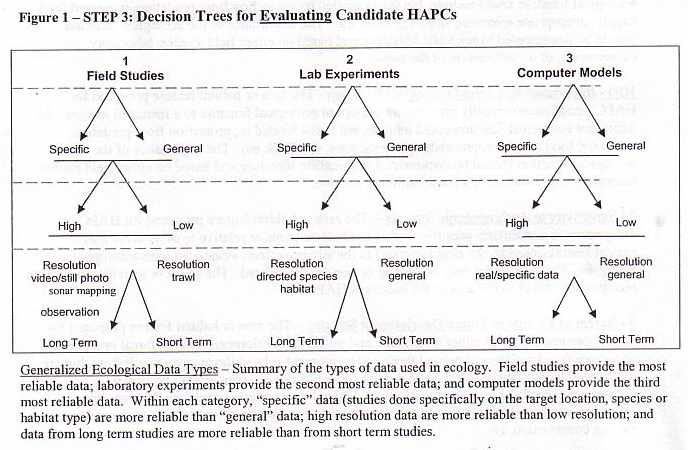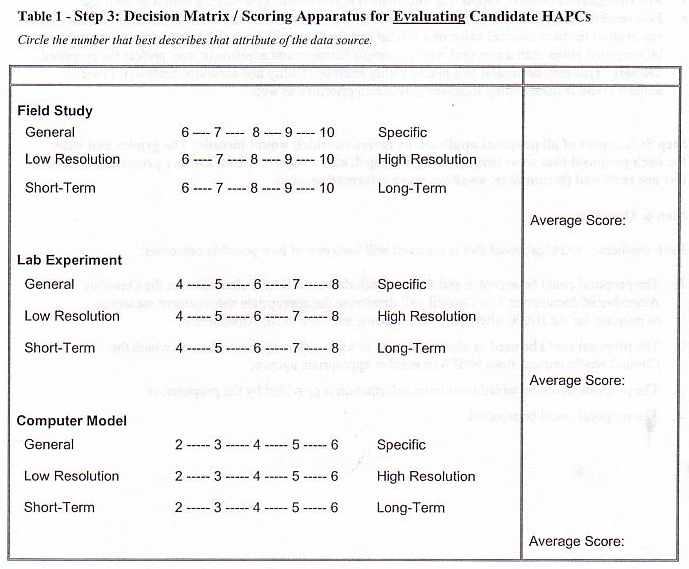Habitat Area of Particular Concern
Candidate Proposals Evaluation Process
Step 1: Does the proposed HAPC meet the criteria established under the EFH Final Rule?
To implement a process for reviewing and establishing appropriate HAPCs in areas where EFH is identified by the New England Fishery Management Council, the Council will consider candidate HAPC proposals based on the criteria identified by NMFS in the EFH Final Rule and described in further detail below:
1(A) - Importance of Historic Ecological Function - The area or habitat feature proposed for HAPC designation at one time provided an important ecological function to a currently managed species, but no longer provides that function due to some form of degradation. An important ecological function could include, but is not limited to, protection from predation, increased food supply, appropriate spawning sites, egg beds, etc. The importance of the ecological function should be documented in scientific literature and based on either field studies, laboratory experiments, or a combination of the two.
1(B) - Importance of Current Ecological Function - The area or habitat feature proposed for HAPC designation currently provides an important ecological function to a managed species. An important ecological function could include, but is not limited to, protection from predation, increased food supply, appropriate spawning sites, egg beds, etc. The importance of the ecological function should be documented in scientific literature and based on either field studies, laboratory experiments, or a combination of the two.
2 - Sensitivity to Anthropogenic Stresses - The area or habitat feature proposed for HAPC designation is particularly sensitive (either in absolute terms or relative to other areas and/or habitat features used by the target species) to the adverse effects associated with anthropogenic activities. These activities may be fishing or non-fishing related. The stress or activity must be a recognizable threat to the area of the proposed HAPC.
3 - Extent of Current or Future Development Stresses - The area or habitat feature proposed for HAPC designation faces either an existing and on-going development-related threat or a planned or foreseeable development-related threat. Development-related threats may result from, but are not limited to, activities such as sand mining for beach nourishment, gravel mining for construction or other purposes, the filling of wetlands, salt marsh, or tidal pools, shoreline alteration, channel dredging (but not including routine maintenance dredging), dock construction, marina construction, etc.
4 - Rarity of the Habitat Type - The habitat feature proposed for HAPC designation is considered "rare" either at the scale of the New England region or at the scale of the range of at least one life history stage of one or more Council-managed species. A "rare" habitat feature is that which is considered to occur infrequently, is uncommon, unusual, or highly valued owing to its uniqueness. Keep in mind that the term "rare" usually implies unusual quality and value enhanced by permanent infrequency. We may usually think of rare habitats or features as those that are spatially or temporally very limited in extent, but it could also be applied to a unique combination of common features that occur only in a very few places.
--------------------------------------------------------------------------------
Page 2
Step 2: Does the supporting information justify the HAPC designation?
1. Is the supporting information relevant to the proposal that the applicant is making?
2. Does the supporting information emphasize the EFH final rule criteria (from step 1) that the applicant is submitting the proposal under?
3. Does the supporting information provide conclusions that are contrary to the applicant's proposal?
4. Is the supporting information outdated or has it been disproved since publication? Is the applicant using the best available science?
Step 3: How strongly does the information support the application?
Figure 1- STEP 3: Decision Trees for Evaluating Candidate HAPCs

-------------------------------------------------------------------------------
Page 3
Table 1 - Step 3: Decision Matrix / Scoring Apparatus for Evaluating Candidate HAPCs
Circle the number that best describes that attribute of the data source.

Step 4: Evaluation of the HAPC based on the criteria and preferences set forth by the Council. (A grading process)
Council Proposal Preferences:
1. Will improve the fisheries management in the EEZ.
2. Include EFH designations for more than one Council-managed species in order to maximize the benefit of the designations.
3. Include juvenile cod EFH.
4. Meet more than one of the EFH Final Rule HAPC criteria.
--------------------------------------------------------------------------------------------
Page 4
Other criteria/considerations:
• The strength/relevance of supporting information is acceptable. (via scoring matrix in Step 2).
• Foreseeable management actions or solutions that are within the Council's ability/authority. (aka - An application for the historical value of a habitat that the Council has no ability/authority to restore may be weighted lower than a proposal where a simple management adjustment may protect the proposed habitat). This may be similar to a practicability analysis (ability and authority analysis). These actions could include setting monitoring/research priorities as well.
Step 5: A report of all proposal applications reviewed which would include:The grades and notes for each proposal that went through Step 1- Step 4, and a record/reason for any proposal received but not reviewed (incomplete, awaiting more information, etc.).
Step 6: Outcome
Each candidate HAPC proposal that is received will have one of four possible outcomes:
1. The proposal could be accepted and the area included as an HAPC alternative in the Omnibus Amendment documents; The Council will determine the appropriate management measures to propose for the HAPC alternative before being included in the Amendment;
2. The proposal could be used to identify an area or topic requiring more research which the Council would request from NMFS or another appropriate agency;
3. The proposal could be tabled until more information is provided by the proposer; or
4. The proposal could be rejected.
Back to Guide to HAPCs off Maine
Back to Bay Management Oversight